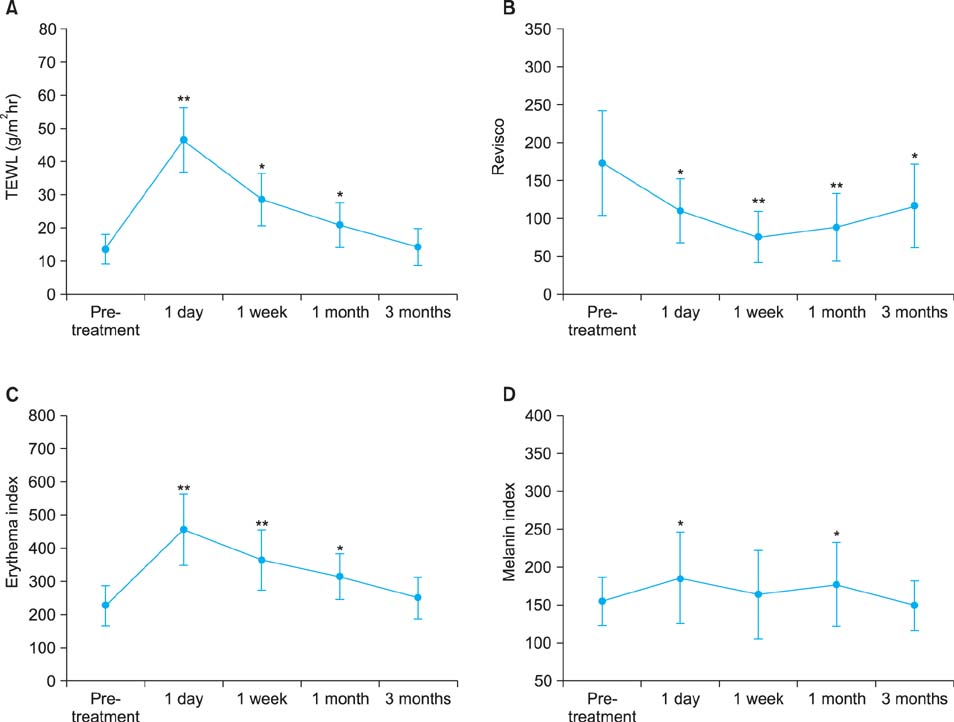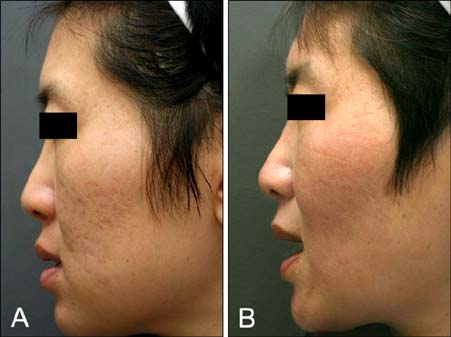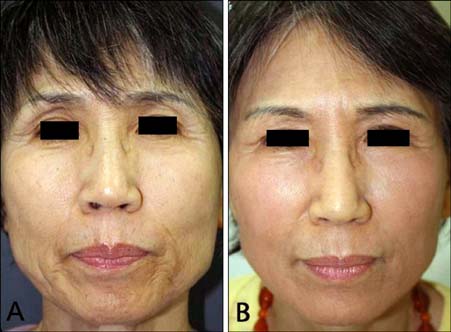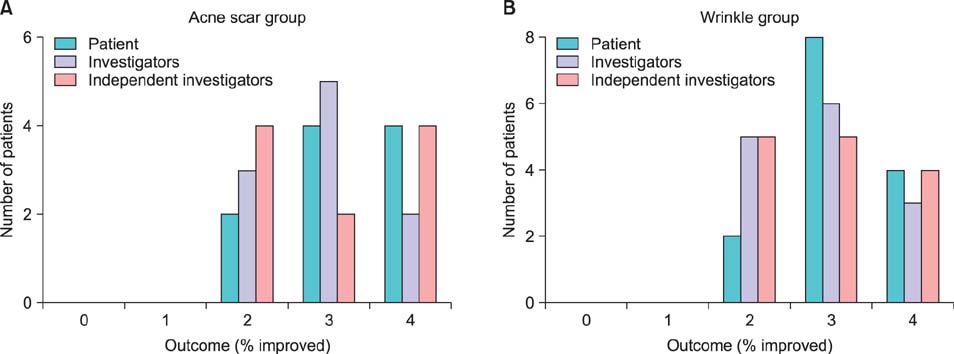Ann Dermatol.
2013 Nov;25(4):445-453. 10.5021/ad.2013.25.4.445.
Treatment of Acne Scars and Wrinkles in Asian Patients Using Carbon-Dioxide Fractional Laser Resurfacing: Its Effects on Skin Biophysical Profiles
- Affiliations
-
- 1Department of Dermatology, Konkuk University School of Medicine, Seoul, Korea. 20050078@kuh.ac.kr
- KMID: 2265055
- DOI: http://doi.org/10.5021/ad.2013.25.4.445
Abstract
- BACKGROUND
Although ablative fractional resurfacing is known to be effective against photoaging and acne scars, studies on its efficacy, safety and changes in the skin characteristics of Asians are limited.
OBJECTIVE
The aim of this study is to assess the efficacy and safety of carbon dioxide fractional laser (CO2FL) in Koreans treated for wrinkles and acne scars, and to define the changes in skin characteristics during recovery period.
METHODS
We administered one session of CO2FL on 10 acne scar patients and 14 wrinkles patients with skin types IV and V. The surveillance of efficacy and side effects along with the measurement of biophysical properties was carried out before 1 day, 1 week, 1 month and 3 months after treatment.
RESULTS
Using a non-invasive method, skin barrier damage, erythema and bronzing of skin during the recovery period were assessed, and all of the items eventually returned to the pre-treatment level. Skin elasticity was measured in the wrinkle group, and the statistically significant effect was sustained throughout the next three months. The outcome of treatment was found to be better than 'moderate improvement' in both the acne scar and wrinkle groups. Further, there were no serious side effects three months post-procedure.
CONCLUSION
CO2 FL is thought to be an effective and safe method for treating moderate to severe acne scars and wrinkles in Asians.
MeSH Terms
Figure
Reference
-
1. Jih MH, Kimyai-Asadi A. Fractional photothermolysis: a review and update. Semin Cutan Med Surg. 2008; 27:63–71.
Article2. Sriprachya-anunt S, Marchell NL, Fitzpatrick RE, Goldman MP, Rostan EF. Facial resurfacing in patients with Fitzpatrick skin type IV. Lasers Surg Med. 2002; 30:86–92.
Article3. Chapas AM, Brightman L, Sukal S, Hale E, Daniel D, Bernstein LJ, et al. Successful treatment of acneiform scarring with CO2 ablative fractional resurfacing. Lasers Surg Med. 2008; 40:381–386.
Article4. Hantash BM, Bedi VP, Kapadia B, Rahman Z, Jiang K, Tanner H, et al. In vivo histological evaluation of a novel ablative fractional resurfacing device. Lasers Surg Med. 2007; 39:96–107.
Article5. Geronemus RG. Fractional photothermolysis: current and future applications. Lasers Surg Med. 2006; 38:169–176.
Article6. Tierney EP, Eisen RF, Hanke CW. Fractionated CO2 laser skin rejuvenation. Dermatol Ther. 2011; 24:41–53.
Article7. Weiss ET, Chapas A, Brightman L, Hunzeker C, Hale EK, Karen JK, et al. Successful treatment of atrophic postoperative and traumatic scarring with carbon dioxide ablative fractional resurfacing: quantitative volumetric scar improvement. Arch Dermatol. 2010; 146:133–140.8. Alexiades-Armenakas MR, Dover JS, Arndt KA. The spectrum of laser skin resurfacing: nonablative, fractional, and ablative laser resurfacing. J Am Acad Dermatol. 2008; 58:719–737.
Article9. Bogdan Allemann I, Kaufman J. Fractional photothermolysis-an update. Lasers Med Sci. 2010; 25:137–144.
Article10. Brightman LA, Brauer JA, Anolik R, Weiss E, Karen J, Chapas A, et al. Ablative and fractional ablative lasers. Dermatol Clin. 2009; 27:479–489.
Article11. Goodman GJ, Baron JA. Postacne scarring-a quantitative global scarring grading system. J Cosmet Dermatol. 2006; 5:48–52.12. Day DJ, Littler CM, Swift RW, Gottlieb S. The wrinkle severity rating scale: a validation study. Am J Clin Dermatol. 2004; 5:49–52.13. Morgan GE, Mikhail MS, Murray MJ, Kleinman W, Nitti GJ, Nitti JT, et al. Clinical anesthesiology. 4th ed. New York: McGraw-Hill;2006.14. Manstein D, Herron GS, Sink RK, Tanner H, Anderson RR. Fractional photothermolysis: a new concept for cutaneous remodeling using microscopic patterns of thermal injury. Lasers Surg Med. 2004; 34:426–438.
Article15. Sasaki GH, Travis HM, Tucker B. Fractional CO2 laser resurfacing of photoaged facial and non-facial skin: histologic and clinical results and side effects. J Cosmet Laser Ther. 2009; 11:190–201.
Article16. Clementoni MT, Gilardino P, Muti GF, Beretta D, Schianchi R. Non-sequential fractional ultrapulsed CO2 resurfacing of photoaged facial skin: preliminary clinical report. J Cosmet Laser Ther. 2007; 9:218–225.
Article17. Berlin AL, Hussain M, Phelps R, Goldberg DJ. A prospective study of fractional scanned nonsequential carbon dioxide laser resurfacing: a clinical and histopathologic evaluation. Dermatol Surg. 2009; 35:222–228.
Article18. Cho SB, Lee SJ, Kang JM, Kim YK, Chung WS, Oh SH. The efficacy and safety of 10,600-nm carbon dioxide fractional laser for acne scars in Asian patients. Dermatol Surg. 2009; 35:1955–1961.
Article19. Manuskiatti W, Triwongwaranat D, Varothai S, Eimpunth S, Wanitphakdeedecha R. Efficacy and safety of a carbon-dioxide ablative fractional resurfacing device for treatment of atrophic acne scars in Asians. J Am Acad Dermatol. 2010; 63:274–283.
Article20. Chan NP, Ho SG, Yeung CK, Shek SY, Chan HH. Fractional ablative carbon dioxide laser resurfacing for skin rejuvenation and acne scars in Asians. Lasers Surg Med. 2010; 42:615–623.
Article21. Walgrave SE, Ortiz AE, MacFalls HT, Elkeeb L, Truitt AK, Tournas JA, et al. Evaluation of a novel fractional resurfacing device for treatment of acne scarring. Lasers Surg Med. 2009; 41:122–127.
Article22. Rahman Z, MacFalls H, Jiang K, Chan KF, Kelly K, Tournas J, et al. Fractional deep dermal ablation induces tissue tightening. Lasers Surg Med. 2009; 41:78–86.
Article23. Tierney EP, Hanke CW, Petersen J, Bartley T, Eckert JR, McCutchen C. Clinical and echographic analysis of ablative fractionated carbon dioxide laser in the treatment of photodamaged facial skin. Dermatol Surg. 2010; 36:2009–2021.
Article24. Katz B. Efficacy of a new fractional CO2 laser in the treatment of photodamage and acne scarring. Dermatol Ther. 2010; 23:403–406.
Article25. Laubach HJ, Tannous Z, Anderson RR, Manstein D. Skin responses to fractional photothermolysis. Lasers Surg Med. 2006; 38:142–149.
Article26. Keagle JN, Welch WJ, Young DM. Expression of heat shock proteins in a linear rodent wound. Wound Repair Regen. 2001; 9:378–385.
Article27. Kono T, Chan HH, Groff WF, Manstein D, Sakurai H, Takeuchi M, et al. Prospective direct comparison study of fractional resurfacing using different fluences and densities for skin rejuvenation in Asians. Lasers Surg Med. 2007; 39:311–314.
Article28. Chan HH, Manstein D, Yu CS, Shek S, Kono T, Wei WI. The prevalence and risk factors of post-inflammatory hyperpigmentation after fractional resurfacing in Asians. Lasers Surg Med. 2007; 39:381–385.
Article
- Full Text Links
- Actions
-
Cited
- CITED
-
- Close
- Share
- Similar articles
-
- Principles and Practices of Fractional Carbon Dioxide Laser
- Laser resurfacing in acne scarring: a review
- Treatment of Facial Wrinkels with Char-Free Carbon Dioxide Laser and Erbium: YAG Laser
- A Pilot Study of Skin Resurfacing Using the 2,790-nm Erbium:YSGG Laser System
- Efficacy and Safety of Treatment with Fractional 1,064-nm Picosecond Laser with Diffractive Optic Element for Wrinkles and Acne Scars: A Clinical Study






